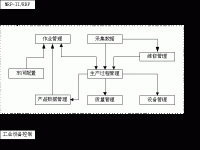
System solutions for automobile manufacturing industry based on barcode technology
[ad_1]
Intelligent Industry’s automobile manufacturing system based on bar code technology provides ERP system interfaces and can easily share relevant data in the ERP system. The system interface is intuitive and clear and easy to operate, reflects comprehensive content, and can simulate operations through the interface to adjust daily Production plan. It has strong data statistics, analysis, tabulation, and query functions. Information transmission is accurate and fast. Make full use of the bar code information source to realize the traceability of parts.
I. Overview
The development of social economy and the intensification of market competition have presented a series of challenges to industrial production. The goals of efficiency, quality, and cost pursued by industrial production in the age of industrialization have been given new content. The number of products produced per unit of time has no longer become the main symbol of corporate competitiveness. The time from product development to product launch is The key for enterprises to win the market and customers, information has become the decisive factor for the survival and development of enterprises, and the production technology and organization management of enterprises are undergoing profound changes.
Product production (inventory, delivery, sales, after-sales information) is related to a single product, so the amount of information is large, the information is widely distributed, and the source of information is complicated. If these materials are collected manually, it will greatly increase the number of information collection personnel and information input personnel, and reduce the accuracy of information. In order to achieve product tracking, manufacturers are constantly looking for new solutions.
As barcode technology matures and is widely used, barcodes can be printed quickly and with high quality (such as using DATAMAX special barcode printers); barcodes can be quickly and accurately identified by various scanners (such as using Welch Allyn barcode readers). Manufacturers use bar codes to identify their products, collect product information during production, inventory, delivery, sales, and after-sales, use computer networks to collect product tracking data from different distributions, and establish data collection and tracking management information systems.
With the continuous development of my country’s automobile industry, some related systems have been introduced one after another. This year my country will formally implement the “Automobile Recall System”. Therefore, some automobile and spare parts suppliers must pay attention to the traceability of parts and components. In this traceability process, Barcode technology has played a key role in tracking and tracing these retail parts by pasting barcode labels on parts.
2. User needs
At present, most automobile manufacturing companies have implemented ERP systems, in order to further build a unified enterprise management information system with ERP as the core, and comprehensively improve the company’s production management level and efficiency. Therefore, these companies will seek a set of management methods combined with ERP systems to facilitate the improvement of workshop production management.
1. Provide ERP system interface, and can easily share relevant data in ERP system
2. The system interface display is intuitive and clear, easy to operate, reflects comprehensive content, and can simulate operations through the interface to adjust the daily production plan
3. It has strong data statistics, analysis, tabulation and query functions
4. Information transmission is accurate and fast
5. Make full use of the bar code information source to realize the traceability of parts
Three, system design
Manufacturing Execution System (MES) is a management information system oriented to the shop floor between the plan management system at the upper level and the industrial control system at the bottom level. It provides operators/managers with the execution and tracking of plans and the current status of resources (people, equipment, materials, customer needs, etc.).

Architecture diagram
The main relationship of the functional structure:
1. The relationship between MES and ERP/MRP-II is two-way data interaction. MES receives ERP/MRP-II production instructions and product data and configuration, and MES returns process reports and completion reports to ERP/MRP-II.
2. MES receives the work-in-process production process parameters generated by the industrial equipment control system as part of the work-in-process production file.
3. Workshop configuration and product data management provide the basis for the formulation of job plans and dispatch of job scheduling in job management.
4. Job management provides scheduling lists and sources of work-in-progress for production process management, and at the same time reflects production instructions or job scheduling production process information through production process management.
5. Collecting data provides data sources for the production process of the production process management, and at the same time provides the defective production process for maintenance management operations. Maintenance management is also provided to production process management as production process data.
6. Perform process statistics on production process management, provide quality management for quality statistics and quality control; archive production process management, and provide product file query and product list query for product data management.
Four, system function

Function diagram
1. Receive ERP data
Receiving BPCS production instructions: MES receives monthly production instructions from ERP through database sharing, adding system production instructions and modifying production instructions without production. The received data includes the production order and its corresponding product production configuration. There is no production order number in the ERP system, and it needs to be automatically generated by the MES system. The production instruction data is: ERP project number, model type, quantity, planned production date.
Product production configuration data are: project notes (including BPCS project numbers or part numbers and notes for engines, frames, axles, body, etc.), and the amount of units.
Receiving BPCS material inventory: MES receives monthly inventory data of BPCS materials through database sharing (received once at the beginning of each month). This data is used to count the monthly balance reports of materials.
Receiving BPCS parts catalog: MES receives BPCS parts catalog data through database sharing, including part number, part name, part price and other information. This data is used to count material monthly inventory reports.
2. Material preparation
The preparation of materials includes the preparation of the body (which can be expanded): the body is directly entered by the body factory, so the body is received in the assembly plant and stored in two warehouses to establish a body material preparation inventory (part number, quantity).
Material preparation: Collect the part number of the car body and designate the storage warehouse to accumulate the material inventory.
Material allocation: According to the material preparation inventory, it is allocated to the detailed operation plan.
Reduce material inventory: The production instruction starts job scheduling, and the required material preparation inventory is deducted.
3. Detailed operation plan
The detailed operation plan includes a complete vehicle supporting operation plan and a separate operation plan for the chassis and interior trim.
1) Complete vehicle supporting operation plan:
Prepare inventory according to materials, arrange production quantities of production instructions, and establish detailed daily operation plans in batches.
The cumulative production order has been planned. When assigning materials, specify the contractor and its specific distribution quantity to reduce the material preparation inventory of the corresponding contractor.
Assign the VIN of the job plan product.
2) Chassis individual operation plan:
Arrange the production quantity of production instructions, and establish detailed daily operation plans in batches.
The cumulative production order has been planned.
Assign the VIN of the job plan product.
3) Individual interior work plan:
Arrange the production quantity of production instructions, and establish detailed daily operation plans in batches.
The cumulative production order has been planned.
[ad_2]



